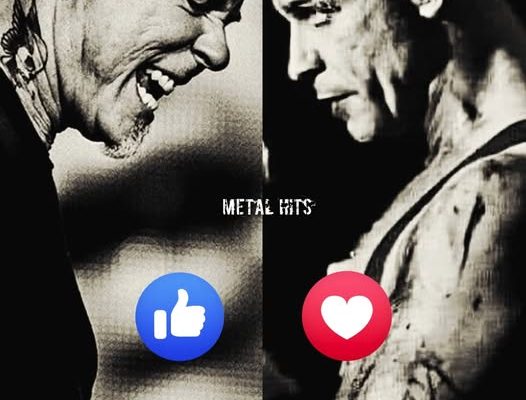In the vast and thunderous world of heavy music, few names stand as tall as James Hetfield, the commanding voice and rhythm guitarist of Metallica, and Till Lindemann, the brooding and theatrical frontman of Rammstein. Both men embody the essence of metal in distinctly different ways—Hetfield with his relentless precision, gruff tone, and unwavering energy that powered Metallica into the pantheon of rock gods, and Lindemann with his menacing stage presence, deep baritone, and operatic approach to industrial metal that transformed Rammstein into a global cultural force. When these two titans are placed side by side, the result is not just a clash of personalities but a symbolic battle between two eras, two philosophies, and two unique legacies that have defined heavy music for generations.
James Hetfield’s story begins in the raw, gritty days of early 1980s California. Metallica was forged in the fires of the thrash scene, a movement that rejected glam excess and sought speed, aggression, and authenticity. Hetfield, with his snarling vocals and relentless downpicking, became the heartbeat of the band. His stage presence—shoulders squared, legs planted wide, guitar slung low—created an image of sheer dominance. Songs like “Master of Puppets,” “Seek and Destroy,” and “Enter Sandman” weren’t just hits; they were cultural shifts, defining what metal could be in arenas, stadiums, and global consciousness. Hetfield’s charisma doesn’t come from flamboyance but from conviction. When he sings, fans don’t just hear the words; they feel the battle scars of addiction, loss, triumph, and resilience etched into every growl and riff.
Till Lindemann’s rise came in a different era, and from a different cultural backdrop entirely. Born in East Germany, Lindemann’s worldview was shaped by division, struggle, and the peculiar mix of repression and artistic defiance that defined life behind the Berlin Wall. When Rammstein emerged in the 1990s, they were unlike anything the West had seen. Blending crushing industrial riffs with theatrical fire shows, provocative lyrics, and Lindemann’s baritone that dripped with menace, Rammstein challenged boundaries both musically and culturally. Lindemann doesn’t just sing; he performs with a sense of operatic menace, weaving shock, eroticism, and satire into his persona. To see Rammstein live is to witness a spectacle where Lindemann becomes both ringmaster and provocateur, dominating not just the stage but the very imagination of the audience.
Where Hetfield embodies grit, honesty, and the raw power of thrash, Lindemann is about spectacle, ambiguity, and challenging comfort zones. Hetfield’s lyrics often grapple with internal struggles, societal flaws, and the universal human condition. Lindemann, by contrast, often sings in German about taboo subjects—violence, sexuality, politics—with an irony that forces listeners to confront discomfort. One man stands for clarity; the other thrives in contradiction.
When discussing stage dominance, the comparison becomes even more fascinating. Hetfield commands crowds of hundreds of thousands with little more than his presence and his riffs. He doesn’t need pyrotechnics to make the ground shake; his guitar is enough. Yet Metallica’s live shows are legendary for their ability to create a sense of intimacy in massive stadiums, with Hetfield’s famous call-and-response chants of “Yeah!” and “Are you alive?” resonating like sermons of unity. His power lies in authenticity—audiences know he means every word, every riff, every growl.
Lindemann, however, has elevated stage performance into high art. Rammstein concerts are notorious for their pyrotechnics, elaborate props, and shocking theatrics. Lindemann has been set on fire, sprayed audiences with foam cannons, and staged scenes of dark satire that blur the line between theater and concert. His presence is magnetic and terrifying at once—an embodiment of controlled chaos. Where Hetfield binds the crowd through trust and kinship, Lindemann captivates through awe, shock, and spectacle.
Both men also carry legacies that extend beyond the music itself. Hetfield’s influence on generations of musicians is immeasurable. Countless guitarists learned to play by mimicking his precise rhythm playing. Bands across the metal spectrum cite Metallica as their gateway into heavy music. Hetfield’s struggles with addiction and his openness about recovery further endeared him to fans, showing that even gods of metal are human. His journey is one of resilience, a symbol that no matter how far one falls, redemption is always possible.
Lindemann’s legacy is different but equally profound. He represents the global voice of German metal, proving that music in languages outside of English could not only thrive but dominate worldwide. Rammstein’s decision to sing primarily in German didn’t limit their audience—it expanded it, creating a cult-like following that spans continents. Lindemann’s daring, his refusal to conform to Western norms of performance, and his willingness to wade into controversy turned Rammstein into cultural icons. He is not just a singer but a provocateur, an artist who forces society to face its own taboos and hypocrisies.
The contrast between Hetfield and Lindemann also speaks to the broader cultural differences in their respective bands. Metallica emerged from the American tradition of rebellion against commercial glam rock, seeking authenticity in aggression. Rammstein, meanwhile, arose from a reunified Germany, where the scars of history and the clash of East and West created fertile ground for art that was both self-aware and subversive. Hetfield and Lindemann are products of their environments, yet they transcended those boundaries to achieve global recognition.
Critics and fans often debate who has the greater charisma, the deeper legacy, the stronger stage dominance. In truth, the comparison is less about who is “better” and more about what they represent. Hetfield represents the classic archetype of the metal frontman: battle-hardened, resilient, and authentic to the core. Lindemann represents the modern evolution: theatrical, controversial, and willing to blur lines between art and provocation. Both approaches are vital to the continued growth of metal as a genre and as a cultural force.
If Hetfield is the relentless warrior, wielding his guitar like a weapon against mediocrity, then Lindemann is the dark poet, cloaked in fire and ambiguity, forcing the world to look into the abyss and confront what it sees. Their “battle” is symbolic—a clash not of rivalry but of legacy, showing how two different paths can both lead to the summit of musical history.
In many ways, Hetfield and Lindemann are mirrors of each other across time and geography. Both built their careers on uncompromising vision. Both command loyalty that borders on devotion from their fans. Both have faced personal struggles that humanize them despite their larger-than-life personas. And both have created music that will outlive them, echoing through arenas, headphones, and hearts for decades to come.
The beauty of this imagined battle is that it reminds us of the diversity within metal itself. The genre is not monolithic; it thrives on contrasts, whether between the clean and the distorted, the melodic and the brutal, the intimate and the theatrical. Hetfield and Lindemann stand as twin beacons of this diversity—one with his raw, stripped-down authenticity, the other with his larger-than-life performance art. Together, they represent the vast spectrum of what heavy music can be.
As long as fans argue, compare, and celebrate these two titans, their legacies grow even stronger. For some, Hetfield will always be the true king—the man who carried Metallica through tragedy, success, and reinvention. For others, Lindemann will be the ultimate icon—the provocateur who dared to redefine what a concert could mean, what a band could represent, and how far art could push boundaries. Both are right. Both deserve their place among the immortals.
When the dust settles in this battle of charisma, legacy, and stage dominance, there is no definitive victor. Instead, we are left with two towering monuments of rock history, standing on opposite ends of the spectrum but connected by the same foundation: a relentless commitment to music that is loud, uncompromising, and unforgettable. James Hetfield and Till Lindemann, though worlds apart, are united as titans whose clash is less a rivalry and more a celebration of metal’s endless power to inspire, provoke, and dominate.
And so, whether you raise your horns to the relentless drive of Hetfield or the theatrical fire of Lindemann, you are participating in the same great tradition of heavy music that thrives on passion, identity, and unapologetic power. This is not just a battle—it is a testament to the enduring spirit of metal, embodied in two men who have forever defined its past, its present, and its future.



